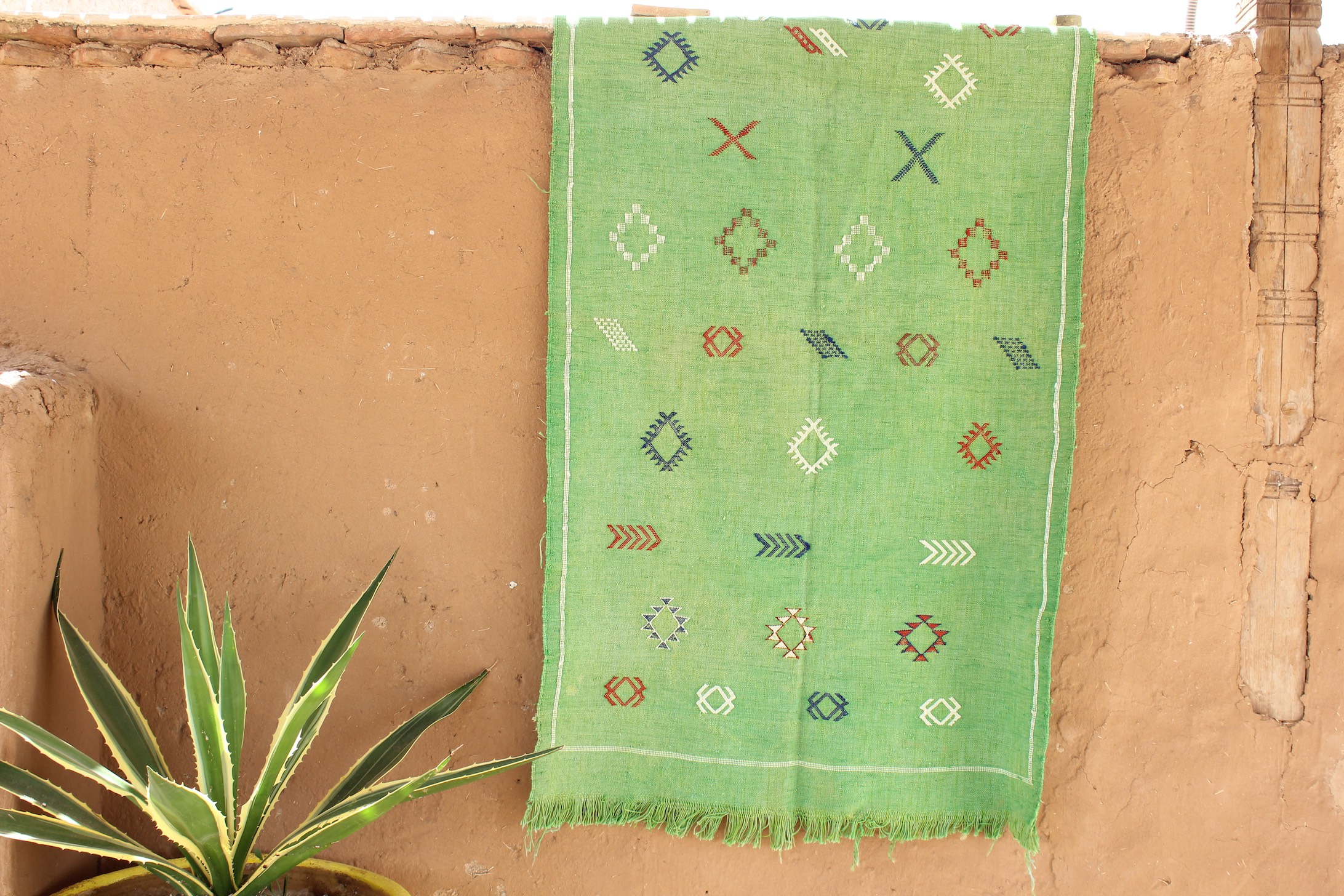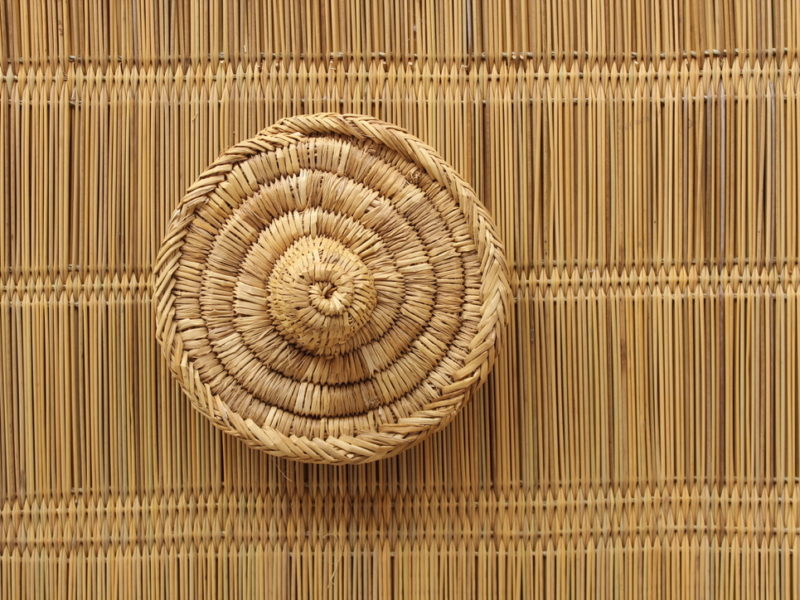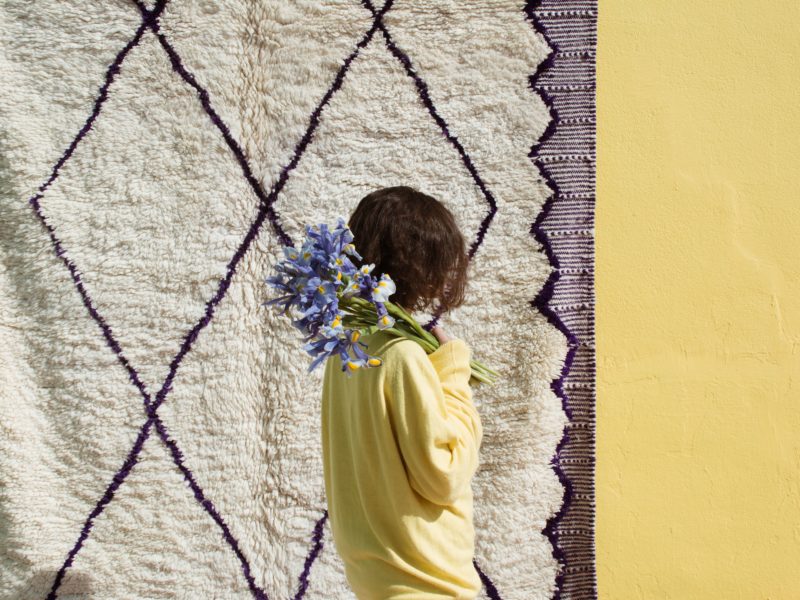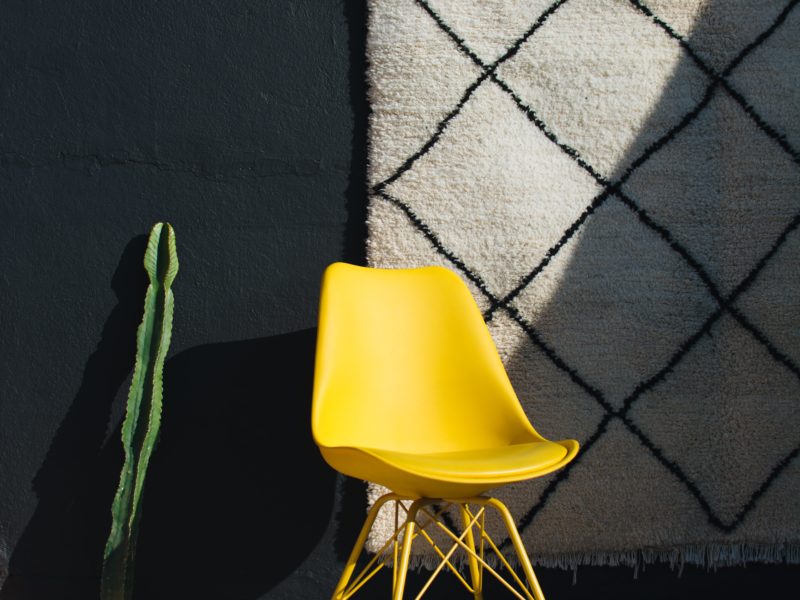Vegetable silk fabric (sabra) carpets, cushions and bolsters
Sabra is a fabric made of vegetable fibers, it is the reason why it is also called vegetable silk or cactus silk, when the fibers comes from Agave or Aloe vera. For Moroccan handicraft, sabra, vegetable silk is used for many products: for weaving, textiles, floor mats, cushions, bolsters, bedspreads, canapés throws and also fancy jewelery.
The city of Marrakech has a worldwide reputation in this area of the sabra. Very used for the ornamentation of the traditional Moroccan clothing, for all the products of interior decoration, cushions, bolsters, bedspreads …, this very shiny and silky thread is extracted from the aloe-vera plant or the agave (a kind of cactus native of Mexico very present in Morocco) to evoke the cactus silk which one also withdraws the fibers or filaments. In all and for all, the fibers of these plants represent the raw material of vegetable silk, which bears its name and gives birth to the so-called sabra tissue. As the fibers are of triangular section, they give and then to the fabric that brilliant effect that makes all its charm, they behave like prisms that reflect light. This is exactly what makes this 100% natural fabric that has the brilliance of silk, without being!
Sabra, cactus silk, vegetable silk …
The plant used is aloe-vera but also agave. For aloe-vera the leaves are soaked in water to extract the fibers, this stage is called retting. For the agave, the leaves are crushed to remove all the green part and thus recover the fibers which will then become white filaments. Retting is the maceration experienced by all textile plants such as hemp, flax and therefore aloe vera and agave. When the fibers separate very easily, this first step is sufficient. Once the fibers are removed, they are carefully prepared and dried in the sun for a few days. The fibers are then, like wool, spun using a loom, worked by hand or embroidered according to the creations and inspirations of weavers or weavers. This work is handmade and entirely handmade, men and women contribute to this art.
These fibers are also dyed by natural and artisanal processes, to obtain colored fibers that will be worked, woven or embroidered to make various works such as carpets, cushion covers, bolster covers, bedspreads, plaids tablecloths, draperies, jewels, bags, as we have already said. <br> The fabric is also used for all kinds of popular textile products, typical and authentic. The sabra or, vegetable silk or so, cactus silk, offers a fabric pleasant to the touch and visually speaking very attractive and very chic! Moreover, it is also a fabric that does not crease, its structure is a little elastic, this is due to the structure of the fibers, it offers a moiré aspect, with brilliant reflections, but above all and above all it is the silky that characterizes the most vegetable silk. Unlike real silk, vegetable silk can be machine washed at 40 ° C for some items, because others will have to be detached and unwashed, indeed, the fibers and the water do not always get together! The products of the craft of the passementerie in Morocco are rather envisaged for the interiors, not too much for the exteriors. In the sun the colors do not resist too much and the heat damages the appearance of the fabric. The weavers of Morocco like to weave the fibers of sabra and sometimes to mix the materials, sabra with cotton, sabra with wool , the sabra really became popular in the Kingdom. This fabric offers warm, shimmering colors, fibers can also be braided, twisted, and wonderfully adorned, babouches, bags, stoles, pompoms, curtains, stripes, draperies … The sabra is used for many things. This very luminous fabric knows how to send back the light, because of this, it always knows to be noticed and thus does not go unnoticed. In the souks of the Kingdom and especially in the souks of Marrakech, it shines on all sides and offers us beautiful colors.
These fibers are also dyed by natural and artisanal processes, to obtain colored fibers that will be worked, woven or embroidered to make various works such as carpets, cushion covers, bolster covers, bedspreads, plaids tablecloths, draperies, jewels, bags, as we have already said. The fabric is also used for all kinds of popular textile products, typical and authentic. The sabra or, vegetable silk or so, cactus silk, offers a fabric pleasant to the touch and visually speaking very attractive and very chic! Moreover, it is also a fabric that does not crease, its structure is a little elastic, this is due to the structure of the fibers, it offers a moiré aspect, with brilliant reflections, but above all and above all it is the silky that characterizes the most vegetable silk. Unlike real silk, vegetable silk can be machine washed at 40 ° C for some items, because others will have to be detached and unwashed, indeed, the fibers and the water do not always get together! The products of the craft of the passementerie in Morocco are rather envisaged for the interiors, not too much for the exteriors. In the sun the colors do not resist too much and the heat damages the appearance of the fabric. <br> <br> The weavers of Morocco like to weave the fibers of sabra and sometimes to mix the materials, sabra with cotton, sabra with wool , the sabra really became popular in the Kingdom. This fabric offers warm, shimmering colors, fibers can also be braided, twisted, and wonderfully adorned, babouches, bags, stoles, pompoms, curtains, stripes, draperies … The sabra is used for many things. This very luminous fabric knows how to send back the light, because of this, it always knows to be noticed and thus does not go unnoticed. In the souks of the Kingdom and especially in the souks of Marrakech, it shines on all sides and offers us beautiful colors.
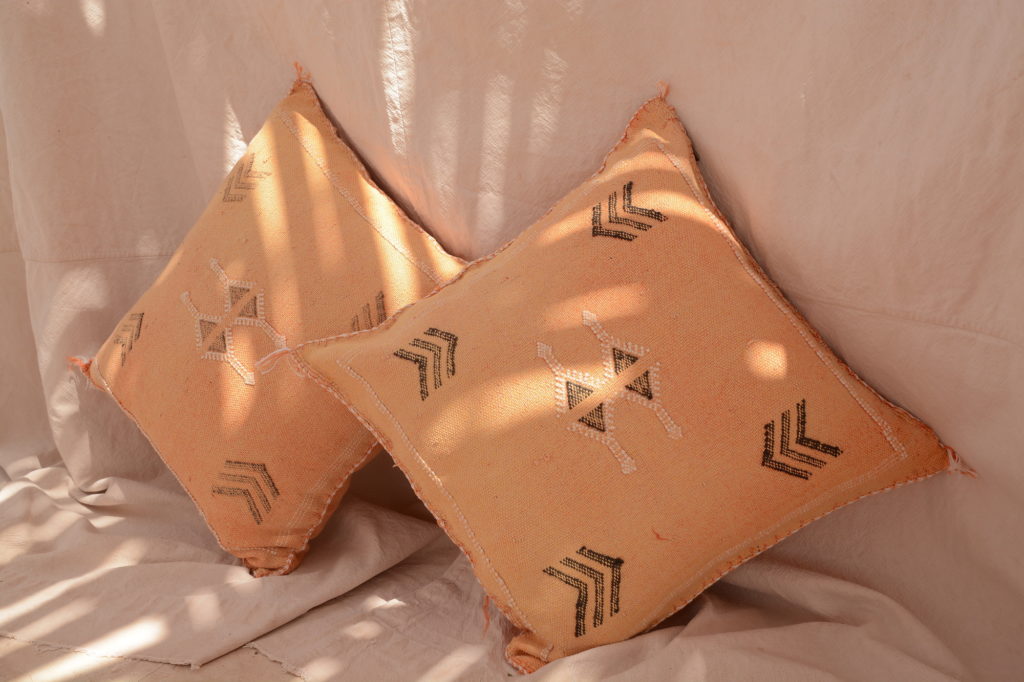
Sabra and more particularly cactus silk
This type of cactus native to Mexico called agave is also very cultivated in Morocco, and again, the fibers are extracted from this plant to make the sabra or said also in these cases: cactus silk. Thus in Morocco, no need to raise silkworms, even if the silk is not the same, vegetable silk is much more respectful of the environment, for a result of the most bluffing as it offers softness , shine and beauty.
So we draw large amounts of fiber from these cacti that grow everywhere and even on arid lands, these fibers therefore produce very good quality plant yarns that then shape wonderful items highly prized in Morocco and around the world. The agave leaves are crushed to remove all the green residues, then there are these whitish colored fibers which will be separated, washed, combed to extract white filaments, which will be worked after and / or tinted with dyes plants
Agave fiber textiles are biodegradable and are very resistant, such as sabra carpets, vegetable silk or cactus silk … In Moroccan crafts, in the form of curtains, bedspreads, cushions, large fabrics, hotels often opt for this unusual decoration that tourists particularly appreciate. Thus, many visitors also want to decorate their interior in this way, which is why all these items are really appreciated. Be careful to make your choice, remember that the true sabra is wrinkle free! It is true that in the past, vegetable silk was only made from Aloe vera fibers, but today it is not uncommon to find in the manufacture of synthetic materials including viscose coupled with wool or cotton, the true sabra is worthy and it is important to trust connoisseurs, at Tribaliste you will find only articles from traditional crafts that respect the skills of the past.
In order not to deceive you, we have selected for you some very beautiful articles straight out of the famous weavers workshops of Marrakech. On our catalog you will discover beautiful vegetable silk carpets, but also covers of cushions and bolsters, objects that should seduce you. For a typical Moroccan interior design, you can trust us! In addition, be aware that by buying products at Tribaliste, you contribute not only to fair trade but also, you encourage this artisanal work that, in Morocco, supports many families. We offer cushions and bolsters in sabra and carpets as below
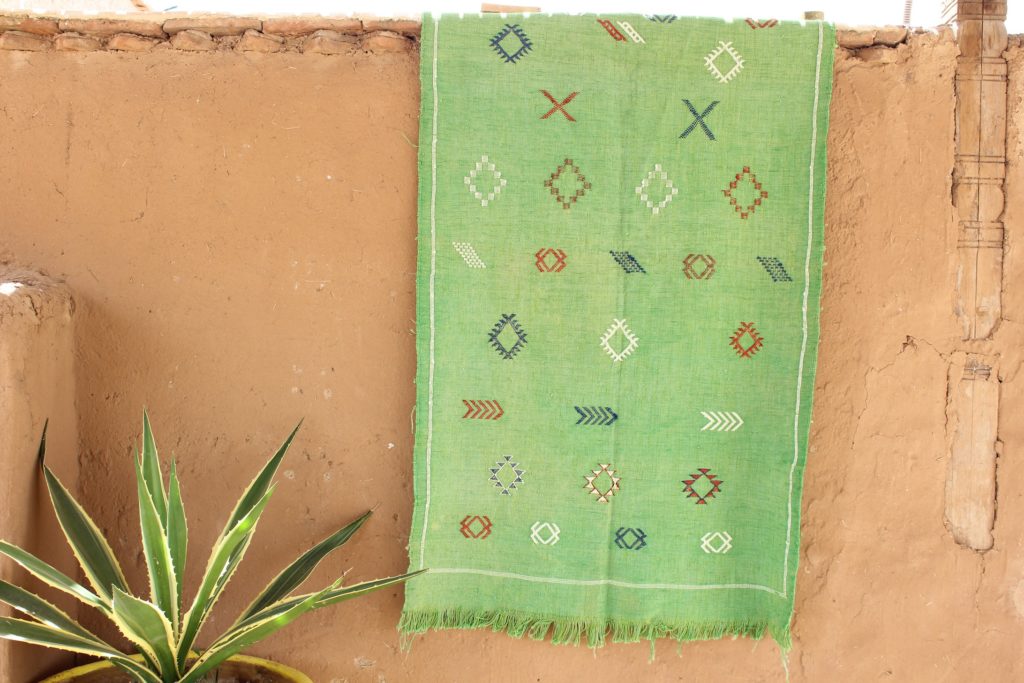
In your room, for a beautiful set sabra you can choose your fabric to make your curtains and your matching bedspread and you can choose your covers of cushions and bolsters. Your room will be worthy of those found in riads or hotels, where the sabra is always highlighted with very nice beanbags. You can also find pretty sabra bags, this silky yarn makes people happier. Henceforth the sabra is no longer an unknown to you, you have nothing left more than to discover it in reality to see its brilliance and all its elegance.
